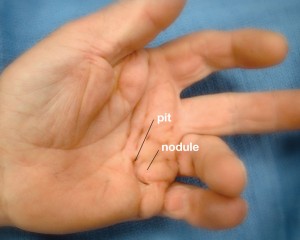 Exeter, NH – September 27, 2011 -You may have seen the recent headlines in The New York Times: Concert Violinist Given Back Use of Her Hands with a Novel Treatment for Dupuytren’s Disease. “What are they talking about?” you may ask. Dupuytren’s disease, also known as Dupuytren’s contracture, is a condition that affects the palm of the hand and can extend into the fingers. It is essentially scar tissue whose formation causes cords or bands that flex the finger down into the palm of the hand and makes everyday use of the hand difficult. As the condition progresses, tasks such as putting your hand in your pocket or putting on gloves becomes more and more difficult, an unpleasant proposition especially during the cold New England winters!
Exeter, NH – September 27, 2011 -You may have seen the recent headlines in The New York Times: Concert Violinist Given Back Use of Her Hands with a Novel Treatment for Dupuytren’s Disease. “What are they talking about?” you may ask. Dupuytren’s disease, also known as Dupuytren’s contracture, is a condition that affects the palm of the hand and can extend into the fingers. It is essentially scar tissue whose formation causes cords or bands that flex the finger down into the palm of the hand and makes everyday use of the hand difficult. As the condition progresses, tasks such as putting your hand in your pocket or putting on gloves becomes more and more difficult, an unpleasant proposition especially during the cold New England winters!
We do not know for sure what causes Dupuytren’s disease, but there is a tendency for it to run in families. It is also more common in men, and usually appears in people over the age of forty. You may have an uncle, father, or grandfather who had “bent down fingers”. There is a strong association between Dupuytren’s disease and Northern European ancestry, leading some to call it “Viking’s Disease.” The condition’s proper name is borrowed from the French physician, Guillaume Dupuytren, who first described the condition.
Early signs of Dupuytren’s disease are nodules or lumps in the palm of the hand or occasionally on the tops of the knuckles that may or may not be painful. Pain, when present, usually resolves, but as the condition progresses, the finger can begin to bend down, impairing function. It typically involves the small (pinkie) and ring fingers, and less commonly the thumb side of the hand. If there is no loss of function of the hand, in essence no contracture, then typically the condition is monitored by your primary care provider or hand specialist.
Dupuytren’s disease is usually progressive over time, and if the condition advances, that is, if contractures begin to develop, then it is important to be evaluated by a doctor who specializes in treatment of conditions of the hand. It is important to address any contractures before they become too severe and functional loss is irreversible.
This is where we come to the “What’s New?” part. In the past, treatment has typically involved surgery. In simple terms, the cord is removed and the finger is “released” to restore full straightening. The recovery is typically longer and individuals often need therapy afterwards to regain motion and strength. However, in the past few years new treatment options have become available, particularly for less severe forms of Dupuytren’s.
Needle aponeurotomy is a fancy term which means that a needle is placed under the skin and the cord is sectioned, allowing restoration of motion. This does not eliminate the cord or the skin changes, but can safely and simply restore finger function. Since there is no cut on the skin, the recovery is fairly quick and there is no need for prolonged therapy. We have used this technique, alone or in combination with a much smaller incision, to restore patient function to a high degree of satisfaction.
Recently the FDA approved a new drug which goes by the trade name of Xiaflex. It is a collagenase, which means that it is an enzyme that breaks up, or dissolves, collagen. Why is this important? You guessed it; the Dupuytren’s cord is made of collagen. Hand specialists who receive additional training can now inject this collagenase into the cord, allowing the cord to dissolve over a period of a day or two. Like needle aponeurectomy, this method does not require an incision, there is no long rehabilitation process, and in some cases can even be done in the office. This treatment works best in the earlier stages of Dupuytren’s disease.
If you have Dupuytren’s disease or think you or a friend or family member may have this condition, ask your primary care provider if you should see a physician who specializes in conditions of the hand. A hand specialist can help with the diagnosis and see if one of these new and exciting treatment options can help restore your hand function and get you back to doing the activities that you enjoy.
Dr. Rod Bruno and Dr. Matt Quitkin direct the Hand Center at Access Sports Medicine & Orthopaedics. They are board certified in Orthopaedics and Hand Surgery. They have recently expanded the Hand Center’s services, providing the most innovative and comprehensive care for patients suffering from diseases and conditions of the hand and upper extremity in Northern New England. They work in conjunction with certified hand and occupational therapists to restore function and improve the quality of life for their patients. Call 603-775-7575 or visit www.accesssportsmed.com for more information or to make an appointment.



